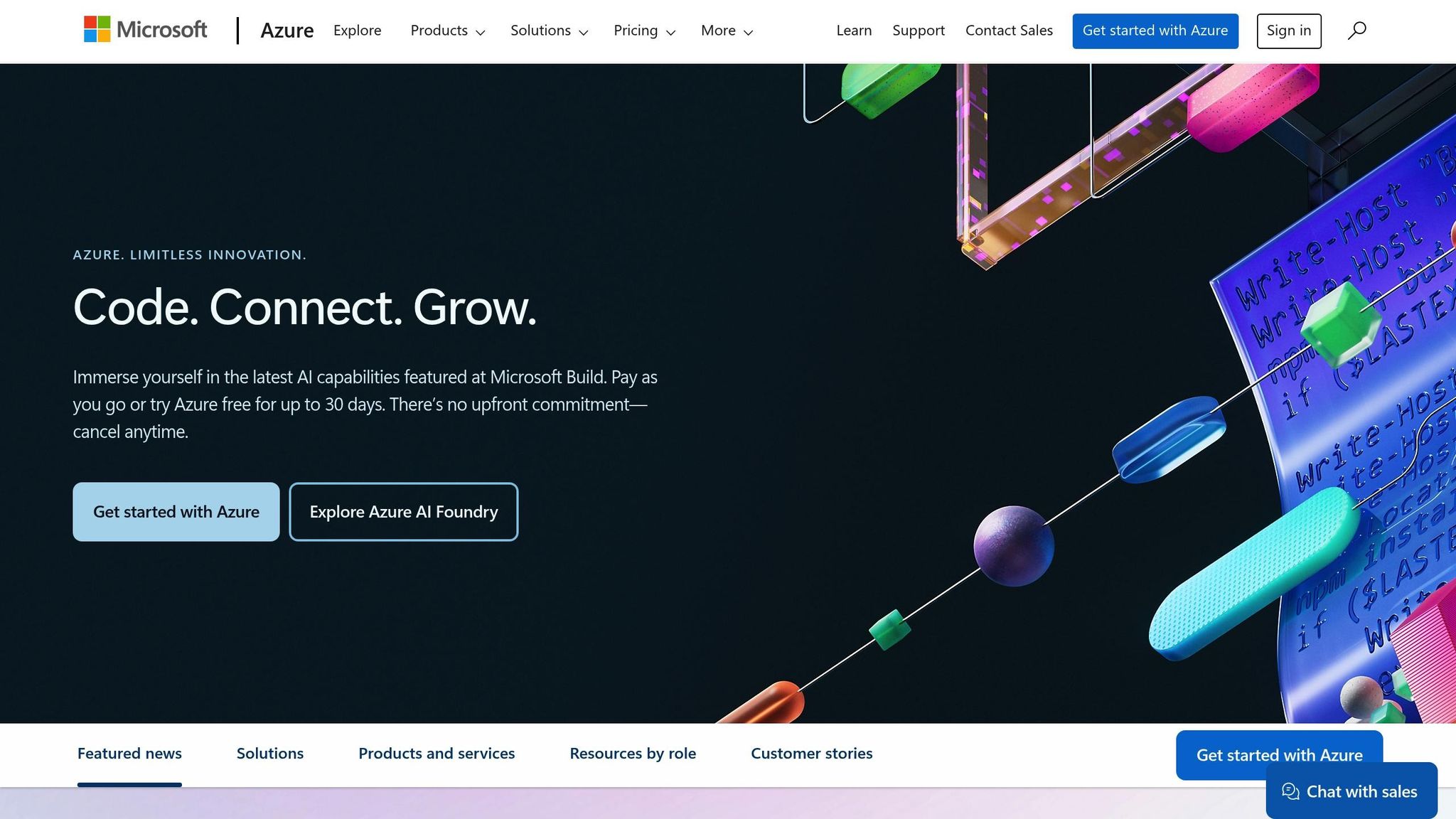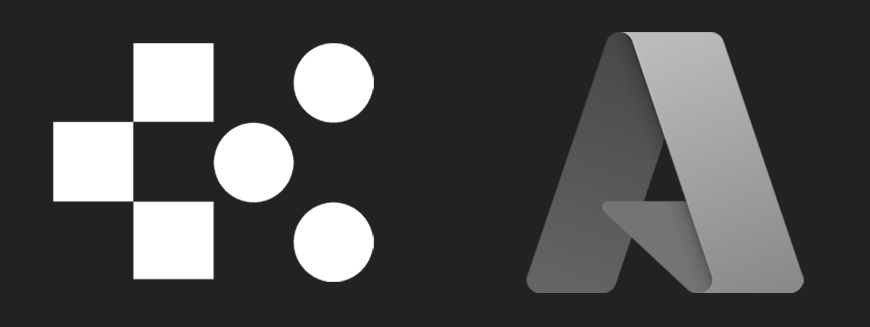Best Practices For Azure ZRS Deployment
Learn how to effectively deploy Azure Zone Redundant Storage, ensuring high availability, cost management, and compliance for your business.

Azure Zone Redundant Storage (ZRS) is a reliable way to protect your data by replicating it across three availability zones within a single region. It ensures high availability, strong data consistency, and minimal downtime (just 5.26 minutes annually). For small and medium-sized businesses (SMBs), ZRS combines cost efficiency with robust data protection, making it ideal for critical workloads.
Key Takeaways:
- What ZRS Offers: Replicates data across three zones within a region using synchronous replication, ensuring durability (12 9s annually) and availability (99.999% uptime).
- Why It’s Ideal for SMBs: Simplifies compliance, balances costs, and avoids the complexity of cross-region management.
- How to Deploy: Configure ZRS in the Azure portal, set up load balancing for resilience, and monitor performance with tools like Azure Monitor.
- Cost Management: Use storage tiering, reserved capacity pricing, and resource tagging to optimise expenses.
- Backup and Recovery: Pair ZRS with geo-redundant options for added protection and test disaster recovery strategies regularly.
- Security and Compliance: Implement Role-Based Access Control (RBAC), encryption, and align with GDPR and UK data protection laws.
ZRS is perfect for businesses needing high availability without overspending. By following these best practices, you can ensure your Azure storage is reliable, secure, and cost-effective.
Azure Storage Redundancy - LRS,ZRS,GRS,GZRS,RA-GRS,RA-GZRS

How to Deploy Azure ZRS
To deploy Azure Zone Redundant Storage (ZRS), you'll need to focus on three key areas: configuring storage, implementing load balancing, and setting up monitoring. These steps ensure your system is prepared for high availability, even during zone outages.
Setting Up Zone Redundant Storage
Creating ZRS storage in Azure is straightforward when using the Azure portal.
To set up a ZRS-enabled virtual machine (VM), start by creating a VM in the portal. During the setup process, navigate to the Disks pane and select a ZRS option from the drop-down menu. Complete the deployment by customising the remaining settings to suit your requirements.
If you’re creating a standalone ZRS disk, select the ZRS option under the Disks tab in the portal. Keep in mind that ZRS is supported on both Premium SSD and Standard SSD managed disks. ZRS is available in various regions, including UK South, North Europe, West Europe, East US, and West US 2, among others.
Adding Load Balancing and Redundancy
Once storage is set up, the next step is enhancing resilience through load balancing. This ensures traffic is distributed across multiple zones, maintaining system performance even if a zone becomes unavailable.
For example, deploying a Standard Load Balancer with zone redundancy ensures that traffic is automatically redirected to healthy zones during outages. Using multiple zonal frontends allows you to assign an IP address to each zone. Pair this with DNS load balancing tools like Traffic Manager, which provides a single DNS name while distributing traffic across zones. Alternatively, Azure Front Door offers global load balancing, complete with health probes that monitor backend availability and reroute traffic away from problematic zones.
For applications that demand the highest availability, consider using ZRS in your primary region while replicating data to a secondary region. Additionally, configuring health probes on regional load balancers ensures that traffic only reaches fully operational instances.
Setting Up Monitoring and Alerts for ZRS
After configuring storage and load balancing, monitoring becomes essential for detecting and addressing issues before they escalate. Azure Monitor provides the tools you need for effective alerting and tracking.
Start by setting up alert rules that define conditions for notifications, specifying the actions to take and the resources to target. Group these actions into action groups - collections of tasks like sending emails or triggering webhooks - to ensure the right teams are notified promptly. To reduce unnecessary alerts, fine-tune criteria by setting thresholds based on your application's typical performance patterns.
Resource Health alerts notify you of changes in the status of individual Azure resources, while service health alerts inform you about outages, planned maintenance, and security advisories. Regularly reviewing and updating alert configurations is crucial. Test alerts to confirm reliability, and consider using dynamic thresholds to adapt to fluctuating traffic patterns. Adding custom properties to alerts can also provide extra diagnostic context, helping you resolve issues faster.
Performance and Cost Management for ZRS Deployments
When it comes to Azure Zone-Redundant Storage (ZRS), balancing performance and cost is a top priority. For small and medium-sized businesses (SMBs), this means cutting down on latency, keeping expenses in check, and ensuring reliable backup strategies while getting the most out of their investment in high availability.
Reducing Latency with Proximity Placement Groups
To keep latency low in ZRS deployments, Proximity Placement Groups (PPGs) can make a big difference. They work by placing compute resources physically close to each other, which is especially useful for applications needing fast data access across multiple zones.
For example, Hansen Cloud tested PPGs in February 2025 using four machines spread across two availability zones and two virtual networks. The results were impressive: PPGs reduced round-trip times by 27–33%. Pairing PPGs with Accelerated Networking can push latency even lower. SAP’s Development Architect, Ventsislav Ivanov, shared:
"During our evaluation, we were able to bring down the latency to less than 0.3 ms between all system components, which is more than sufficient to ensure great system performance. Best deterministic results we achieved when PPGs were combined with Network acceleration of VM NICs, which additionally improved the measured latencies."
However, keep in mind that a proximity placement group is tied to a single availability zone. This means careful planning is required to balance the benefits of proximity with the redundancy needed for a resilient setup.
Cost Management Strategies for ZRS
Managing costs in ZRS deployments requires thoughtful choices. As FinOps expert Cody Slingerland explains:
"Cost optimisation is not just about reducing your cloud costs; it is also about understanding what tradeoffs to make, what to prioritise, and even where you can invest more to maximise your returns (ROI)."
Here are some effective strategies:
- Storage tier adjustments: Moving data from the hot tier (£0.195 per GB) to the cold tier (£0.0045 per GB) can save up to 97.69% on storage costs. Use lifecycle policies to automatically transition data between tiers based on usage patterns - keeping frequently accessed data in the hot tier and moving older, less-used data to colder storage.
- Reserved capacity pricing: For predictable workloads, Azure Reservations can cut costs by up to 72% compared to pay-as-you-go pricing. Similarly, Azure Savings Plans can reduce compute expenses by up to 65%. For non-critical tasks, Azure Spot VMs offer discounts of up to 90%.
- Resource tagging: Tagging resources by department, project, or cost centre helps track spending and identify waste. Regularly clean up unused resources like old VMs, redundant storage accounts, and idle databases.
For more detailed tips on managing Azure costs, check out the Azure Optimization Tips, Costs & Best Practices blog, which provides expert advice on cloud architecture, security, and performance.
Setting Up Backup and Recovery Plans
A strong backup and recovery plan is essential for protecting your ZRS deployment from regional disasters, accidental data loss, and compliance risks.
- Cross-region replication: Use geo-redundant storage (GRS) or read-access geo-redundant storage (RA-GRS) to replicate critical data to a secondary region. This ensures data availability during regional outages while maintaining zone-level resilience.
- Automated backup policies: Leverage Azure Backup to schedule regular snapshots of ZRS-enabled virtual machines and managed disks. Set retention policies that balance compliance with cost - for instance, daily backups for 30 days, weekly backups for 12 weeks, and monthly backups for 12 months.
- Archive storage for long-term retention: For compliance data that needs to be kept for extended periods, archive storage offers a low-cost option at just £0.002 per GB.
Testing your backup and recovery processes is just as important as setting them up. Perform regular restore tests in isolated environments to ensure your strategy meets business needs. Document recovery time objectives (RTO) and recovery point objectives (RPO) for different scenarios. For added resilience, consider using Azure Site Recovery for automated failover capabilities that complement ZRS's built-in redundancy.
Finally, monitor your backup costs using Azure Cost Management tools. Incremental backups, rather than full ones, can save storage space, and regularly reviewing retention policies ensures they align with your current requirements.
Security and Compliance Considerations
Protecting your Azure ZRS deployment is crucial for safeguarding data, maintaining user trust, and adhering to UK data protection laws.
Access Control and Encryption
A strong security setup begins with Azure Role-Based Access Control (RBAC). This tool helps manage who can access resources and what they can do with them. RBAC operates on three key elements: security principals (users, groups, or applications), role definitions (sets of permissions), and scope (the specific resources those permissions apply to). To maximise security, follow the principle of least privilege by granting users only the permissions they absolutely need. For instance, rather than assigning the Reader role broadly at the subscription level, limit access to specific resource groups or individual resources. You can also create custom roles with tailored permissions to suit unique requirements. Azure’s built-in roles are a good starting point, but regular audits are essential to ensure compliance and optimise permissions.
Azure ZRS automatically encrypts data at multiple levels. Every Azure Storage account uses 256-bit AES encryption by default, but you can take things further by using customer-managed keys or adding another layer with Infrastructure encryption. For managing encryption keys securely, Azure Key Vault is invaluable. As Microsoft explains:
"Azure Key Vault is designed, deployed, and operated such that Microsoft and its agents are precluded from accessing, using or extracting any data stored in the service, including cryptographic keys."
For data in transit, enforce SSL/TLS protocols. While Azure portal interactions default to HTTPS, make sure secure transfer is enabled for REST API calls. Additionally, use SMB 3.0 for Windows Server 2012 or newer VMs and SSH for Linux VMs to keep data encrypted as it moves across Azure Virtual Networks. Regularly update and securely store encryption keys in Azure Key Vault, and classify data to apply the appropriate encryption measures.
Lastly, ensure your deployment aligns with regulatory requirements under UK GDPR and other local standards.
Compliance with GDPR and Local Regulations
In the UK, data protection is governed by the UK General Data Protection Regulation (UK GDPR) and the Data Protection Act 2018. Breaches of these laws can result in fines of up to £17.5 million or 4% of global turnover. The Information Commissioner’s Office (ICO) enforces these regulations, requiring organisations to handle personal data lawfully, fairly, and transparently. Data must only be collected for specific, legitimate purposes, retained only as long as necessary, and processed securely to prevent unauthorised access.
For UK businesses, data sovereignty is a pressing concern. Although data stored in Azure ZRS remains in the UK, Microsoft acknowledges that it cannot guarantee full data sovereignty, especially when data is processed or accessed for support. This limitation raises questions about control over sensitive information. Mark Boost, CEO of Civo, highlights this risk:
"The inability to ensure data remains within UK borders underscores the risks of depending on hyperscalers. If we keep outsourcing critical data infrastructure, we risk losing more than just technical control, we lose national independence."
Jon Cosson, head of IT and chief information security officer at JM Finn, adds:
"Data sovereignty is not a buzzword, it's survival."
In September 2024, the UK government classified datacentres as critical national infrastructure (CNI). Additionally, the Data Use and Access (DUA) Bill mandates that international data transfers meet standards equivalent to those in the UK.
To comply with these regulations, conduct thorough risk assessments and implement strict security controls. Keep detailed records of data processing activities, perform Data Protection Impact Assessments (DPIAs) when required, and appoint a Data Protection Officer (DPO) if necessary. Contracts with third parties should include clauses ensuring adherence to data protection laws, and organisations must follow ICO guidelines carefully. Prompt responses to regulatory inquiries are also critical. Building a compliance-focused culture - through solid encryption, secure access measures, proactive cybersecurity, and regular collaboration with legal experts - will help your ZRS deployment stay in line with evolving standards.
It’s also worth noting that while the EU currently recognises the UK’s data protection framework for cross-border data flows, this adequacy status is subject to review. Keeping up with changes related to data sovereignty and Brexit is vital.
Testing and Validating ZRS Deployments
Thorough testing ensures your ZRS setup meets expectations for availability, performance, and disaster recovery. By validating your deployment, you can uncover potential weaknesses before they disrupt operations, giving you confidence in your system's ability to handle challenges. Start by simulating zone failures and reviewing performance metrics to confirm your resilience strategy.
Testing Zone Failures
Understanding how your ZRS deployment reacts to zone failures is a key part of assessing its resilience. You can simulate these failures using two primary methods: cordoning and draining nodes or leveraging Azure Chaos Studio for controlled fault injection.
Cordoning and draining involves marking nodes in a specific zone as unschedulable and evicting pods from those nodes. This replicates a zone outage scenario. Using the kubectl drain command, you can remove workloads and test data durability. However, this process may cause temporary service interruptions.
To take it a step further, Azure Chaos Studio offers a controlled environment for fault injection. It allows you to stop or restart virtual machines to evaluate the impact on your applications, using metrics and logs for analysis. For instance, Janne Mattila demonstrated this in August 2024 with a 3-node AKS cluster. By simulating a failure in availability zone 2, he observed that affected pods were automatically rescheduled to other nodes as the impacted node's status switched to "NotReady".
As Mattila explains the methodology behind chaos engineering:
"Formulate hypotheses around resiliency scenarios, craft and execute a fault injection experiment in a safe environment, monitor the impact, analyse results and make improvements."
Azure Chaos Studio supports various fault types and integrates with Azure Monitor for detailed insights. However, it requires additional setup and may not cover all potential failure scenarios, which could limit the scope of your tests.
Both approaches serve distinct purposes. Cordoning and draining give you hands-on control to simulate real-world failures, while Azure Chaos Studio enables repeatable, automated experiments that can be scheduled regularly. Together, they form the foundation for effective performance monitoring and resilience testing.
Performance Monitoring and Tuning
Tracking the right metrics is essential for understanding and optimising your ZRS deployment. Azure Monitor is the go-to tool for analysing Azure Files metrics, such as availability, latency, and usage patterns. Key metrics to monitor include:
- Availability: The percentage of successful requests.
- Success E2E Latency: Total latency, including network delays.
- Success Server Latency: Latency within the Azure Files service.
- Egress and Ingress: Data volumes for outbound and inbound traffic.
- Transactions: The number of operations or requests.
For provisioned file shares, it’s also important to track Transactions by Max IOPS and Bandwidth by Max MiB/s to measure peak workload performance.
| Metric | Description | Recommended Aggregation |
|---|---|---|
| Availability | Percentage of successful requests | Average |
| Success E2E Latency | Total latency, including network | Average |
| Success Server Latency | Latency within the Azure Files service | Average |
| Egress/Ingress | Outbound/inbound data volume | Sum |
| Transactions | Number of operations or requests | Count |
| Transactions by Max IOPS | Peak IOPS achieved | Maximum |
| Bandwidth by Max MiB/s | Peak throughput achieved | Maximum |
Microsoft underscores the importance of monitoring file share performance:
"Understanding how to monitor file share performance is critical to ensuring that your application is running as efficiently as possible."
Azure Storage Analytics can provide additional insights into usage, performance, and capacity. Platform and custom metrics are retained for up to 93 days. Setting up alerts for issues like file share throttling, capacity limits, excessive egress, or high server latency can help you catch problems early.
Performance data can also guide optimisation efforts. For example, if you encounter metadata IOPS throttling (Azure file shares scale up to 12,000 metadata IOPS), you can enable Metadata Caching for SSD SMB file shares or distribute workloads across multiple file shares. Monitoring the Average aggregation for Availability can reveal patterns in request errors, while the Sum aggregation for Egress and Ingress offers insights into overall data transmission.
Regular disaster recovery (DR) testing is another vital step. Tools like Azure Site Recovery (ASR) can automate DR testing, but it’s best to perform test failovers in an isolated network separate from your production environment. Frequent DR drills, combined with continuous performance monitoring through Azure Monitor, help ensure your failover processes are effective. Remember, while ZRS protects data within a region, achieving maximum resilience against regional disasters may require using GRS or RA-GRS.
Conclusion
Azure ZRS offers an impressive 12 9s durability and ensures seamless data availability across zones. For small and medium-sized businesses (SMBs) aiming to strike a balance between cost efficiency and robust data protection, ZRS stands out as a reliable solution. Even in the event of a zone failure, ZRS keeps operations running smoothly.
In terms of cost, ZRS is 1.5 times less expensive than traditional replication methods while still providing enterprise-level resilience. This affordability is even more compelling when you consider that managed disks already deliver 99.999% availability and 99.999999999% (11 9s) durability as standard.
When planning your implementation, a gradual approach is key. Begin with critical workloads that demand high availability, then expand as you gain confidence and expertise. While ZRS performs exceptionally well within regions, you may need to incorporate geo-redundant options for a more comprehensive disaster recovery strategy.
Testing and monitoring are not optional - they’re essential for maintaining service quality. Regular chaos engineering experiments and continuous performance monitoring through tools like Azure Monitor ensure your setup delivers consistent value as your business grows.
Cost management is an ongoing process. As Cody Slingerland aptly puts it:
"Cost optimization is not just about reducing your cloud costs; it is also about understanding what tradeoffs to make, what to prioritize, and even where you can invest more to maximize your returns (ROI)".
This mindset is particularly relevant to ZRS deployments, where thoughtful decisions around redundancy and performance tiers can have a significant impact on your overall costs.
For additional guidance on refining your cloud strategy, resources like Azure Optimization Tips, Costs & Best Practices offer insights into managing costs, enhancing security, and fine-tuning performance for growing businesses.
ZRS provides a solid foundation for advanced, scalable cloud architectures. Whether you're planning to expand internationally, meet regulatory requirements, or simply ensure your data remains accessible during outages, the strategies outlined here offer a practical starting point. Gradual adoption and a focus on high availability will help you build a resilient and future-ready cloud environment.
FAQs
What makes Azure Zone Redundant Storage (ZRS) unique, and how can it benefit small and medium-sized businesses?
Azure Zone Redundant Storage (ZRS)
Azure Zone Redundant Storage (ZRS) offers a unique advantage by synchronously replicating your data across three separate availability zones within the same Azure region. This setup guarantees exceptional availability and data reliability, backed by an impressive 99.9999999999% (12 nines) SLA. Unlike Locally Redundant Storage (LRS), which confines data to a single data centre, ZRS is designed to withstand zone-level outages, ensuring uninterrupted access to your data even during disruptions.
For small and medium-sized businesses, ZRS is an excellent choice for handling critical workloads. It provides a cost-conscious way to meet high-availability standards while ensuring your operations remain resilient. With ZRS, businesses focused on reliability can confidently maintain service continuity, even in the face of zone-level failures.
How can I set up monitoring and alerts in Azure ZRS to ensure high performance and quick issue resolution?
To keep Azure ZRS running smoothly and to address issues quickly, it’s crucial to have a solid monitoring and alert system in place. Azure Monitor is a great tool for this - use it to keep an eye on important metrics like throttling, storage capacity, and data egress. Setting up alert rules can help you spot unusual activity or problems in your storage accounts, and linking these alerts to action groups ensures you’ll get instant notifications when something’s off.
It’s also important to track the redundancy status to make sure ZRS is operating as it should and maintaining data resilience. Staying proactive with monitoring means you can act fast if anything goes wrong, helping to minimise downtime and keep performance on track.
How can businesses comply with UK GDPR and local regulations when using Azure ZRS for data storage?
Ensuring UK GDPR Compliance with Azure Zone Redundant Storage (ZRS)
When using Azure Zone Redundant Storage (ZRS), it's essential to store your data in UK-based data centres to meet UK GDPR and local regulations. Azure offers the option to specify regional data residency, ensuring your data remains within the UK while benefiting from high security and redundancy. This is achieved by storing three copies of your data across separate availability zones.
To formalise compliance, make sure to review and sign a Data Processing Agreement (DPA) with Microsoft. This agreement is a key step in adhering to regulatory requirements. Additionally, your organisation should implement clear consent mechanisms for collecting and processing personal data, especially if any of the data is stored outside the EU but still within the UK’s jurisdiction.
Finally, it’s crucial to regularly evaluate your data management practices. Keeping these practices aligned with changing regulations will help you maintain compliance and avoid potential legal issues.




